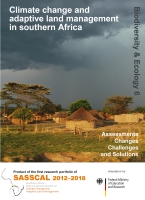
|

Department of Biology Institute of Plant Science and Microbiology |
| Division BEE > Biodiversity & Ecology > Vol.6 > Article 8.5 |
Biodiversity & Ecology
Journal of the Division Biodiversity, Evolution and Ecology of Plants , Institute for Plant Science and Microbiology, University of Hamburg.
Biodiversity Research article Open Access Vegetation survey of the woodlands of Huíla Province
Resumo: O levantamento da vegetação foi realizado nos bosques da Província da Huíla, Angola, com o objectivo de investigar as comunidades arbóreas e associações de espécies. O processo de amostragem da vegetação foi realizado em parcelas de 1 000 m2, onde todas as árvores com diâmetro à altura do peito (DBH) igual ou acima de 5 cm foram medidas. Avaliámos no total 456 parcelas de vegetação, que resultou num total de 32 080 indivíduos medidos. A classifi cação da vegetação foi feita com recurso ao algorítimo ISOPAM que resultou em 13 comunidades distintas. A família mais dominante foi Fabaceae, subfamília Caesalpinioideae, seguida da família Combretaceae e Euphorbiaceae. A classifi cação da vegetação resultou em sete comunidades de miombo, duas comunidades de Mopane, duas comunidades de Baikiaea-Baphia-Terminalia, e duas outras comunidades distintas. Em geral, as comunidades de miombo foram as mais diversas. O estudo representa o primeiro levantamento feito na região com uso de parcelas, e poderá proporcionar as bases para a elaboração do primeiro mapa de vegetação da Província da Huíla.
Suggested citation: |
